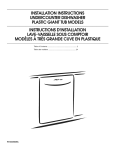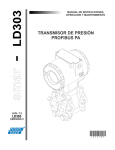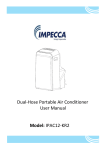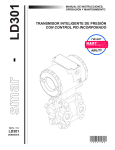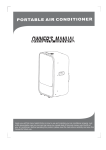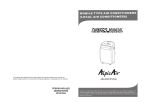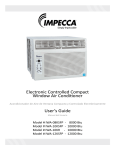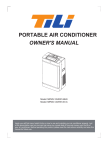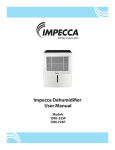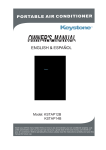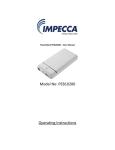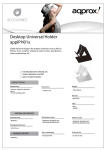Download Impecca 12,000 BTU portable AC Owner`s Manual
Transcript
For service support, contact Impecca at 1-888-918-3456. For sales inquiries, contact Sylvane at 1-800-934-9194. Impecca Portable Air Conditioner Users Manual IPAC-12K—12,000 BTU portable A/C IPAH-12K—12,000 BTU H&C portable A/C IPAC-14K—14,000 BTU portable A/C IPAH-14K—14,000 BTU H&C portable A/C 1 Table of Contents: – Introduction . . . . . . . . . . . . . . . . . . . . . . . . . . . . . . . . . . . . . . . . . . . . . . . . . . . . . . . . . . . . . . . . . . . . . . . . . . . . . . . . . . . . . . p.1 – Safety Precautions. . . . . . . . . . . . . . . . . . . . . . . . . . . . . . . . . . . . . . . . . . . . . . . . . . . . . . . . . . . . . . . . . . . . . . . . . . . . . . . . . p.1 – What’s In The Box. . . . . . . . . . . . . . . . . . . . . . . . . . . . . . . . . . . . . . . . . . . . . . . . . . . . . . . . . . . . . . . . . . . . . . . . . . . . . . . . . . p.2 – Installation Accessory Kit Items. . . . . . . . . . . . . . . . . . . . . . . . . . . . . . . . . . . . . . . . . . . . . . . . . . . . . . . . . . . . . . . . . . . . p.2 – Specifications & Warnings . . . . . . . . . . . . . . . . . . . . . . . . . . . . . . . . . . . . . . . . . . . . . . . . . . . . . . . . . . . . . . . . . . . . . . . . . p.3 – Environmental Operating Conditions . . . . . . . . . . . . . . . . . . . . . . . . . . . . . . . . . . . . . . . . . . . . . . . . . . . . . . . . . . . . . . p.3 – Device parts identification. . . . . . . . . . . . . . . . . . . . . . . . . . . . . . . . . . . . . . . . . . . . . . . . . . . . . . . . . . . . . . . . . . . . . . . . . p.4 – Installation Instructions. . . . . . . . . . . . . . . . . . . . . . . . . . . . . . . . . . . . . . . . . . . . . . . . . . . . . . . . . . . . . . . . . . . . . . . . . . . . p.5 – Energy Conservation Tips. . . . . . . . . . . . . . . . . . . . . . . . . . . . . . . . . . . . . . . . . . . . . . . . . . . . . . . . . . . . . . . . . . . . . . . . . . p.6 – Operating Panel Overview. . . . . . . . . . . . . . . . . . . . . . . . . . . . . . . . . . . . . . . . . . . . . . . . . . . . . . . . . . . . . . . . . . . . . . . . . p.8 – Operating Instructions . . . . . . . . . . . . . . . . . . . . . . . . . . . . . . . . . . . . . . . . . . . . . . . . . . . . . . . . . . . . . . . . . . . . . . . . . . . . p.9 – Additional Features. . . . . . . . . . . . . . . . . . . . . . . . . . . . . . . . . . . . . . . . . . . . . . . . . . . . . . . . . . . . . . . . . . . . . . . . . . . . . . . p.10 – Basic Error Codes & Solutions. . . . . . . . . . . . . . . . . . . . . . . . . . . . . . . . . . . . . . . . . . . . . . . . . . . . . . . . . . . . . . . . . . . . . p.10 – Troubleshooting . . . . . . . . . . . . . . . . . . . . . . . . . . . . . . . . . . . . . . . . . . . . . . . . . . . . . . . . . . . . . . . . . . . . . . . . . . . . . . . . . p.11 – Contact Support . . . . . . . . . . . . . . . . . . . . . . . . . . . . . . . . . . . . . . . . . . . . . . . . . . . . . . . . . . . . . . . . . . . . . . . . . . . . . . . . . p.11 – Care instructions. . . . . . . . . . . . . . . . . . . . . . . . . . . . . . . . . . . . . . . . . . . . . . . . . . . . . . . . . . . . . . . . . . . . . . . . . . . . . . . . . p.12 Regulatory Warnings: Disposal: Do not dispose this product as unsorted municipal waste. Collection of such waste separately for special treatment is necessary. It is prohibited to dispose of this appliance in domestic household waste. For disposal, there are several possibilities: A) The municipality has established collection systems, where electronic waste can be disposed of at least free of charge to the user. B) When buying a new product, the retailer will take back the old product at least free of charge. C) The manufacturer will take back the old appliance for disposal at least free of charge to the user. D) As old products contain valuable resources, they can be sold to scrap metal dealers. Wild disposal of waste in forests and landscapes endangers your health when hazardous substances leak into ground-water and find their way into the food chain. Caution: • This appliance is not intended for use by persons (including children) with reduced physical, sensory or mental capabilities, or lack of experience and knowledge, unless they have been given supervision or instruction concerning use of the appliance by a person responsible for their safety. • Children should be supervised to ensure that they do not play with the appliance. Introduction: Congratulations on your purchase of an IMPECCA™ Electronic Controlled Portable Air Conditioner. Before using this product, it is recommended that you familiarize yourself with the features, functions, and operating procedures described in this manual. Inside you will find many helpful hints on how to use and maintain your air conditioner properly. Just a little preventive care on your part can save you a great deal of time and money over the lifespan of your air conditioner. You will find many answers to common problems in the chart of troubleshooting tips. Save Time and money! If you review our chart of Troubleshooting Tips first, you may not need to call for service at all. Features At A Glance: • Quiet Operation • Ion Filter (select models) • Energy Saver Function • Sleep mode • Remote Control with LED • Eco-Friendly Refrigerant • Remote Personal Temperature Sensor (select models) Safety Precautions:  To prevent injury and/or property damage, please familiarize yourself with the following instructions and safety precautions. Failure to comply with the instructions and cautions mentioned in this manual may cause harm or damage. The seriousness is classified by the following indications: ⚠ WARNING This symbol indicates the possibility of serious injury or death. ⚠ CAUTION This symbol indicates the possibility of injury and/or damage to property. ⊘ ⍟ Never do this. Always do this. IMPORTANT: • Always contact an authorized service technician for repair or maintenance of this unit. • This air conditioner is not intended for use by young children or elderly persons without supervision. • Young children should be advised not to operate the air conditioner. • If the power cord is to be replaced, replacement work should only be performed by certified or authorized technicians. • All electrical work must be performed in accordance with the national wiring standards and should only be performed by authorized personnel. Note: Due to slight modifications in production, the instructions, features, and/or descriptions found in this manual might vary slightly from your product. 1 WHAT’s In THe box: Please verify your box for the following items . Note that some models may not include all items . ❷ ❸&❹ 1 . Air Conditioning Unit 2 . Remote control (may differ from photo) 3 . User’s Guide 4 . Remote control user’s guide 5 . Installation kit (see details below) ❶ InsTAllATIon ACCessoRy KIT ITeMs: Your model may not include some optional mounting accessories, as noted by the symbol * . Illustrations may vary slightly from actual appearance of product . PART (for illustration only, may not be identical) PART DesCRIPTIon: QUAnTITy InClUDeD: Exhaust hose and adapter A –OR– adapter B 1 set Wall Exhaust Adapter A* 1 piece (optional) Round Mouth Adapter B* 1 piece (optional) Expansion Plug & Wooden Screw* 4 pieces (optional) Foam Seal 3 pieces Remote Controller & Battery 1 piece Drain hose and adapter* 1 piece (optional) Avoid damaging your new appliance! If required accessories are missing, please contact technical support . 2 Specifications & Warnings: Carefully review all of these specifications and warnings BEFORE operating your air conditioner unit. Failure to do so may cause damage, injury, or bodily harm including permanent disability and/or death. WARNING For Your Safety • Do not store or use gasoline or other flammable vapors/liquids in the vicinity of this or any other appliance. • Avoid fire hazard or electric shock. Do not use an extension cord or an adaptor plug. Do not remove any prong from the power cord. WARNING Electrical Information • Be sure your electrical wiring is adequate for the model you have chosen. This information can be found on the serial plate, which is located on the side of the cabinet and behind the grille. • Be sure the air conditioner is properly grounded. To minimize shock and fire hazards, proper grounding is important. The power cord is equipped with a three-prong grounding plug for protection against shock hazards. • Your air conditioner must be connected to a properly grounded wall receptacle. If the wall receptacle you intend to use is not adequately grounded or protected by a time delay fuse or circuit breaker, have a qualified electrician install the proper receptacle. • Ensure the receptacle is accessible after the unit installation. ⍟ Always Do This! ⍟ ⊘ Never Do This! ⊘ • Your air conditioner should be used in such a way that it is protected from moisture. e.g. condensation, splashed water, etc. Do not place or store your air conditioner where it can fall or be pulled into water or any other liquid. If unit is in contact with liquid, unplug immediately. • Always transport your air conditioner in a vertical position and stand on a stable, level surface during use. • Turn off the product when not in use. • Always contact a qualified person to carry out repairs. If the supply cord is damaged, it must be repaired by a qualified repairer. • Keep an air path of at least 12” (30cm) all around the unit from walls, furniture and curtains. • If the air conditioner is knocked over during use, turn off the unit and unplug immediately. • Do not operate your air conditioner in a wet room such as a bathroom or laundry room. • Do not touch the unit with wet or damp hands or when barefoot. • Do not press the buttons on the control panel with anything other than your fingers. • Do not remove any fixed covers. Never use this appliance if it is not working properly, or if it has been dropped or damaged. • Never use the plug to start and stop the unit. Always use the switch on the control panel. • Do not cover or obstruct the inlet or outlet grille. • Do not use hazardous chemicals to clean or come into contact with the unit. Do not use the unit in the presence of flammable substances or vapors such as alcohol, insecticides, petrol, etc. • Do not allow children to operate the unit unsupervised. • Do not use this product for functions other than those described in this instruction manual. Environmental Operating Conditions: The air conditioner must be operated within the temperature ranges indicated below: Mode Room Temperature Cooling F: 62° to 95° | C: 17° to 35° Fan or DEHUMIDIFYING F: 55° to 95° | C: 13° to 35° Heating (heat pump models) F: 62° to 88° | C: 5° to 30° Heating (electrical heating models) F: under 88° | C: under 30° 3 Device Parts Identification: Front Panel: 1) Operation panel 2) Horizontal blade (swing automatically) 3) Rolling casters 4) Carrying handles (both sides) Rear Panel: 5) Upper air filter (Behind the grille) 6) Upper air intake 7) Air outlet 8) Drain outlet (only for heat pump model) 9) Power cord outlet 10) Power cord buckle (Used only when storing the unit) 11) Bottom tray drain outlet 12) Power plug socket (Use only when storing the unit) 13) Lower air filter (Behind the grille) 14) Lower air intake 15) Drain outlet 4 Installation Instructions: Carefully review all of these instructions BEFORE proceeding to install and operate your air conditioner unit. Failure to do so may cause damage, injury, or bodily harm including permanent disability and/or death. Location: • The air conditioner should be placed on a firm foundation to minimize noise and virbration. For safe and secure positioning, place the unit on a smooth, level floor strong enough to support the unit. • The unit has casters to aid placement, but it should only be rolled on smooth, flat surfaces. Use caution when rolling on carpet surfaces. Do not attempt to roll the unit over objects. • The unit must be placed within reach of a properly rated grounded socket. • Never place any obstacles around the air inlet or outlet of the unit. • Allow 1 to 3 feet (30cm to 100cm) of space from the wall with for efficient air-conditioning and prevent overheating. Exhaust Hose Installation: The exhaust hose and adaptor must be installed or removed in accordance with the usage mode. INSTALLED—Cooling, heat pump, or auto mode REMOVED—Heating (electric), fan or dehumidify mode 1. Install the adapter A or adapter B onto the exhaust hose as shown in Figure A or Figure B. 2. Resert the hook of the Exhaust hose into the hole seat of the air outlet and slide down the Exhaust hose along the arrow direction for installation. (see Figure C) The exhaust hose can be installed into the wall (not applicable to units without adaptor A, expansion plugs and wood screw accessories). 1. Prepare a hole in the wall. Install the wall exhaust adaptor A onto the exterior/outdoor wall using the 4 expansion plugs and wooden screws. Be sure to fasten securely. (see Figure D) 2. Attach the Exhaust hose to wall Exhaust adaptor A. Note: Cover the exhaust hole using the adaptor cap when not in use. The exhaust hose can becompressed or extended moderately according to installation requirements, but it is preferable to shorten the hose to desired length. IMPORTANT: DO NOT OVERBEND OR KINK THE EXHAUST HOSE (see Figure E) CAUTION EXHAUST PORT Make sure that there are no obstacles within 18” or 50cm around the exhaust outlet in order for the exhaust system to work properly. 5 Installation Instructions (Continued): Water Drainage: Certain functions of your air conditioning unit create condensation and must evacuate accumulated water. Please carefully follow these instructions according to your operating and usage conditions. dehumidifying mode: Remove the upper drain plug from the back of the unit, install the drain connector (5/8 universal female mender) with 3/4” hose (available in local hardware stores). For the models without a drain connector, simply attach the drain hose to the hole. Place the open end of the hose adaptor directly over the drain area in your basement floor. (see Figure F) Heat Pump mode: Remove the lower drain plug from the back of the unit, install the drain connector (5/8” universal female mender) with standard 3/4” hose (available in local hardware stores). For the models without drain connector, just attach the drain hose to the hole. Place the open end of the hose adaptor directly over the drain area in your basement floor. (see Figure G). NOTE: Make sure the hose is secure so there are no leaks. Direct the hose toward the drain, making sure that there are no kinks that will stop water flow. Place the end of the hose into the drain and make sure the end of the hose is down to let the water flow smoothly. (see Figures F, G, & H). Do not lift up the hose to cause drainage to fall back in. (see Figure I). When the water level of the bottom tray reaches a predetermined level, the unit beeps 8 times, the digital display area shows error P1. At this time the air conditioning/dehumidification process will immediately stop. However, the fan motor will continue to operate (this is normal). Carefully move the unit to a drain location, remove the bottom drain plug and let the water drain away (see Figure J). Reinstall the bottom drain plug and restart the machine until the P1 symbol disappears. If the error repeats, call for service. NOTE: Be sure to reinstall the bottom drain plug before using the unit. $$$ Save & Conserve Energy • Use the unit in the recommended room size. • Locate the unit where furniture cannot obstruct the air flow. • Keep blinds/curtains closed during the sunniest part of the day. • Keep the filters clean. • Keep doors and windows closed to keep cool air in and warm air out 6 Installation Instructions: Window Slider Kit Installation (Optional): Your window slider kit has been designed to fit most standard vertical and horizontal window applications, However, it may be necessary for you to improvise/modify some aspects of the installation procedures for certain types of windows. Please refer to Figure K & Figure L for minimum and maximum window openings. Window slider kit can be fixed with a bolt (see Figure M). Window Slider Sizing Chart Use the following chart to determine minimum and maximum gap sizes for exhaust installation within windows. If the window opening is shorter than the noted minimum length of the window slider kit, cut the slider kit to the appropriate length. NEVER cut the kit shorter than the hole. Type I Type II A 67.5 cm 56.2 cm a 2.22 ft. 1.84 ft. B 123 cm 98.2 cm b 4.04 ft 3.22 ft • A columns correpsond to minimum size • B columns correspond to maximum size Installation In A Double-Hung Sash Window: 1. Cut the foam seal (adhesive type) to the proper length and attach it to the window stool. (see Figure N) 2. Attach the window slider kit to the window stool. Adjust the length of the window slider kit according to the width of window, shorten the adjustable window kit if the width of window is less than 26.5 (Type I) or 22.1 (Type II) inches Open the window sash and place the window slider kit on the window stool. (see Figure O) 3. Cut the foam seal(adhesive type) to the proper length and attach it on the top of the window. (see Figure P) 4. Close the window sash securely against the window. 5. Cut the foam seal to an appropriate length and seal the open gap between the top window sash and outer window sash. (see Figure Q) 7 Installation in a sliding sash window: 1. Cut the foam seal(adhesive type) to the proper length and attach it to the window frame. (see Figure R) 2. Attach the window slider kit to the window stool. Adjust the length of the window slider kit according to the width of window, shorten the adjustable window kit if the width of window is less than 26.5 (Type I) or 22.1 (Type II) inches. Open the window sash and place the window slider kit on the window stool. (see Figure S) 3. Cut the foam seal (adhesive type) to the proper length and attach it on the top of the window. (see Figure T) 4. Close the sliding sash securely against the window. 5. Cut the foam seal to an appropriate length and sea the open gap between the top window sash and outer window sash. (see Figure U) Front Panel Overview: The following diagram and legend shows the functions of the front operating panel. Some functions are only available on select models. 1) Power Function 2) Sleep button 3) Fan/Ion* Button 5) Mode selector button Alternate between Auto, Cool, Dry, Fan & Heat modes 6) Timer button Control fan speed between low, medium, high and auto. Press and hold for 3 seconds to enable/disable the ion air purification feature. Activate the unit for a set period of time, increased and decreased using the + and – buttons 4) Up (+) and Down (–) Buttons Activate the swing feature and/or stop the directional blade in its position manually. Use to increase or decrease temperature. To change between degree display in F or C, press and hold both + and – buttons simultaneously for 3 seconds. 7) Swing button 8) LED display Displays the set temp., in fan/dry mode displays actual temp. 8 9) Follow Me indicator light* Function activated via remote control ONLY–Follow Me functionality is only available on select units. Operating Instructions: TIMER operation COOLING operation • When the unit is on, press the • Press the “MODE” button until the “COOL” indicator light comes on. • Timer button will initiate the Auto-off stop program, the TIMER OFF indicator light illuminates. Press the UP or down button to select the desired time. Press the TIMER button again within 5 seconds, the Auto-on start program is initiated. And the TIMER ON indicator light illuminates. Press the up or down button to select the desired Auto-on start time. • Press the ADJUST buttons “+” or “ - “ to select your desired room temperature. The temperature can be set within a range of 17°C-30°C/62°F-88°F. • Press the “FAN SPEED” button to choose fan speed. HEATING operation • Press the “MODE” button until the “HEAT” indicator light comes on. • When the unit is off, press the Timer button to initiate the Auto-on start program,press it again within five seconds will initiate the Auto-off stop program. • Press the ADJUST buttons “+” or “ - “ to select your desired room temperature. The temperature can be set within a range of 17°C-30°C/62°F-88°F. • Press or hold the UP or DOWN button to change the Auto time by 0.5 hour increments, up to 10 hours, then at 1 hour increments up to 24 hours. Thecontrol willcountdown the time remaining until start. • Press the “FAN SPEED” button to choose the fan speed. For some models, the fan speed can not be adjusted under HEAT mode. • Press the “MODE” button until the “DRY” indicator light comes on. • The system will automatically revert back to display the previous temperature setting if there is no operation in a five seconds period. • Under this mode, you cannot select a fan speed or adjust the temperature. The fan motor operates at LOW speed. • Turning the unit ON or OFF at any time or adjusting the timer setting to 0.0 will cancel the Auto Start/ Stop timer program. • Keep windows and doors closed for the best dehumidifying effect. • Do not connect the duct to window. • When the malfunction (E1,E2,E3 or E4) occurs, the Auto Start/Stop timed program will also be cancelled. AUTO operation • When you set the air conditioner in AUTO mode, it will automatically select cooling, heating(cooling only models without), or fan only operation depending on what temperature you have selected and the room temperature. SLEEP operation • Press this button, the selected temperature will increase (cooling) or decrease (heating) by 1°C/2°F after 30 minutes. The temperature will then increase (cooling) or decrease (heating) by another 1°C/2°F after an additional 30 minutes. • The air conditioner will control room temperature automatically round the temperature point set by you. • The new temperature will be maintained for 7 hours before it returns to the originally selected temperature. This ends Sleep mode and the unit will continue to operate as originally programmed. • Under AUTO mode, you can not select the fan speed. FAN operation • Press the “MODE” button until the “FAN “ indicator light comes on. • NOTE: This feature is unavailabe under FAN or DRY mode. • Press the “FAN SPEED” button to choose the fan speed. The temperature cannot be adjusted. • Do not connect the duct to window. 9 Additional Features: FOLLOW ME Feature: Self Protection • After the unit has stopped, it can not restart operation for 3 minutes following shut down. This is to protect the unit. Operation will automatically resume after 3 minutes has elapsed. • NOTE:This feature can be activated from the remote control ONLY. The remote control acts as a remote thermostat allowing for the precise temperature control at its location. • To activate the Follow Me/Temp Sensing feature, point the remote control towards the unit and press the Follow Me/Temp Sensing button. The remote display is actual temperature at its location. The remote control will send this signal to the air conditioner every 3 minutes interval until press the Follow Me/Temp Sensing button again. Air flow direction adjustment • The directional blade can be adjusted automatically. • Adjust the air flow direction automatically • When the Power is ON, the blade opens fully. • Press the SWING button on the panel or remote controller to initiate the Auto swing feature. • If the unit does not receive the Follow Me/Temp Sensing signal during any 7 minutes interval, the unit will beep to indicate the Follow Me/Temp Sensing mode has ended. • The blade willl swing up and down automatically. • Press the SWING button again to block the blade in a fixed direction. Auto Restart • NOTE: Please do not adjust the blade manually. • If the unit breaks offunexpectedly due to the power cut, it will restart with the previous function setting automatically when the power resumes. Basic Error Codes: Use the following guidelines to understand and troubleshoot common error codes. E1: Room temperature sensor error. • Unplug the unit and plug it back in. • If error repeats, call for service. E2: Evaporator temperature sensor error • Unplug the unit and plug it back in. • If error repeats, call for service. E3: Condenser temperature sensor error • Unplug the unit and plug it back in. • If error repeats, call for service. E4: Display panel communication error • Unplug the unit and plug it back in. • If error repeats, call for service. P1: Bottom condensation tray is full • Connect the drain hose and drain the collected water away. • Note that frequent draining may be required, especially in humid climates and during seasonal weather changes. • If protection repeats after draining, call for service. 10 Troubleshooting Tips: Problem Unit does not start when pressing on/off button Room not cool enough Machine noisy or vibrates Possible Causes Remedies P1 appears in the display window Drain the water in the bottom tray Room temperature is lower than the set temperature (cool mode) Reset the temperature The windows or doors in the room are not closed Make sure all the windows and doors are closed There are heat sources inside the room Remove the heat sources if possible Exhaust air duct is not connected or Connect the duct and make sure blocked it can function properly Temperature setting is too high Decrease the set temperature Air filter is blocked by dust Clean the air filter The ground is not level or not flat enough Place the unit on a flat, level surface if possible The sound comes from the flowing Gurgling noises of the refrigerant inside the air This noise is normal conditioner unit The automatic overheat protection function kicks in. When the temSwitch on again after the unit has Power shuts off in heating mode perature at the aur outlet exceeds cooled off. 158°F/70°C, the device will automatically shut off. Contact Support: Impecca customer support can be contacted in the following methods: • Online 24/7: www.impeccausa.com • By e-mail: [email protected] • By phone: +1 888.918.3456 11 Care & Maintenance: IMPORTANT: 1) Be sure to unplug the unit before cleaning or servicing. 2) Do not use gasoline, thinner or other chemicals to clean the unit. 3) Do not wash the unit directly under a tap or using a hose. It may cause electrical danger. 4) If the power cord is damaged, it should be repaired by manufacture or its agency. AIR FILTER CLEANING: Clean the air filter at least once every two weeks to prevent inferior fan operation because of dust. REMOVAL: This unit has two filters. Take the upper filter out along the the arrow direction (Figure 1), then take the filter down. Remove the lower filter by loosening the screw, taking out the filter as shown in (Figure 1). CLEANING: Wash the air filter by immersing it gently in warm water (about 40°C/104°F) with a neutral detergent. Rinse the filter and dry it in a shady place. MOUNTING: Install the upper air filter after cleaning , and install the lower filter by using the screw (see Figure 2). UNIT ENCLOSURE: Use a lint-free cloth soaked with neutral detergent to clean the unit enclosure. Finish by wiping with a dry clean cloth. BEFORE STORING OR NOT USING A UNIT FOR LONG PERIODS OF TIME: Remove the rubber plug at the back of the unit and attach a hose to drain outlet. Place the open end of the hose directly over the drain area in your basement floor. (see Figures F, G, H and I on page 6) Remove the plug from the bottom drain outlet, all the water in the bottom tray would drain out (see Figure J on page 6) Keep the appliance running on FAN mode for half a day in a warm room to dry the appliance inside and prevent mold from forming. Stop the appliance and unplug it, wrapped the cord and bundle it with the tape (Figure 3). Clean the air filter and reinstall it (see above). Remove batteries from the remote controller. 12 Aire Acondicionado Portátil Impecca Manual de Usuario IPAC-12K—12,000 BTU portable A/C IPAH-12K—12,000 BTU H&C portable A/C IPAC-14K—14,000 BTU portable A/C IPAH-14K—14,000 BTU H&C portable A/C 13 Table of Contents: – Introduction . . . . . . . . . . . . . . . . . . . . . . . . . . . . . . . . . . . . . . . . . . . . . . . . . . . . . . . . . . . . . . . . . . . . . . . . . . . . . . . . . . . . . . p.1 – Safety Precautions. . . . . . . . . . . . . . . . . . . . . . . . . . . . . . . . . . . . . . . . . . . . . . . . . . . . . . . . . . . . . . . . . . . . . . . . . . . . . . . . . p.1 – What’s In The Box. . . . . . . . . . . . . . . . . . . . . . . . . . . . . . . . . . . . . . . . . . . . . . . . . . . . . . . . . . . . . . . . . . . . . . . . . . . . . . . . . . p.2 – Installation Accessory Kit Items. . . . . . . . . . . . . . . . . . . . . . . . . . . . . . . . . . . . . . . . . . . . . . . . . . . . . . . . . . . . . . . . . . . . p.2 – Specifications & Warnings . . . . . . . . . . . . . . . . . . . . . . . . . . . . . . . . . . . . . . . . . . . . . . . . . . . . . . . . . . . . . . . . . . . . . . . . . p.3 – Environmental Operating Conditions . . . . . . . . . . . . . . . . . . . . . . . . . . . . . . . . . . . . . . . . . . . . . . . . . . . . . . . . . . . . . . p.3 – Device parts identification. . . . . . . . . . . . . . . . . . . . . . . . . . . . . . . . . . . . . . . . . . . . . . . . . . . . . . . . . . . . . . . . . . . . . . . . . p.4 – Installation Instructions. . . . . . . . . . . . . . . . . . . . . . . . . . . . . . . . . . . . . . . . . . . . . . . . . . . . . . . . . . . . . . . . . . . . . . . . . . . . p.5 – Energy Conservation Tips. . . . . . . . . . . . . . . . . . . . . . . . . . . . . . . . . . . . . . . . . . . . . . . . . . . . . . . . . . . . . . . . . . . . . . . . . . p.6 – Operating Panel Overview. . . . . . . . . . . . . . . . . . . . . . . . . . . . . . . . . . . . . . . . . . . . . . . . . . . . . . . . . . . . . . . . . . . . . . . . . p.8 – Operating Instructions . . . . . . . . . . . . . . . . . . . . . . . . . . . . . . . . . . . . . . . . . . . . . . . . . . . . . . . . . . . . . . . . . . . . . . . . . . . . p.9 – Additional Features. . . . . . . . . . . . . . . . . . . . . . . . . . . . . . . . . . . . . . . . . . . . . . . . . . . . . . . . . . . . . . . . . . . . . . . . . . . . . . . p.10 – Basic Error Codes & Solutions. . . . . . . . . . . . . . . . . . . . . . . . . . . . . . . . . . . . . . . . . . . . . . . . . . . . . . . . . . . . . . . . . . . . . p.10 – Troubleshooting . . . . . . . . . . . . . . . . . . . . . . . . . . . . . . . . . . . . . . . . . . . . . . . . . . . . . . . . . . . . . . . . . . . . . . . . . . . . . . . . . p.11 – Contact Support . . . . . . . . . . . . . . . . . . . . . . . . . . . . . . . . . . . . . . . . . . . . . . . . . . . . . . . . . . . . . . . . . . . . . . . . . . . . . . . . . p.11 – Care instructions. . . . . . . . . . . . . . . . . . . . . . . . . . . . . . . . . . . . . . . . . . . . . . . . . . . . . . . . . . . . . . . . . . . . . . . . . . . . . . . . . p.12 Avisos de Regulación: ELIMINACIÓN: No se deshaga de este producto como basura local común. Es necesaria la recolección de esta basura para un tratamiento especial. Está prohibido desechar este aparato entre la basura doméstica. Para su eliminación, existen varias posibilidades: A) El municipio tiene establecido sistemas de recolección, donde la basura electrónica se puede desechar sin cargo alguno para el usuario. B) Cuando se compra de un producto nuevo, el minorista puede retirar el producto viejo incluso de forma gratuita. C) El fabricante tomará de nuevo el aparato viejo para su eliminación incluso sin cargo alguno para el usuario. D) Dado que los productos viejos contienen recursos valiosos, se pueden vender a los recicladores de metal. La disposición de los residuos en los bosques y áreas naturales pone en peligro su salud cuando las sustancias peligrosas se filtran en las aguas subterráneas, y llegan a la cadena alimenticia. PRECAUCIÓN: •Este aparato no está destinado para ser utilizado por personas (incluidos niños) con disminución en sus capacidades físicas, sensoriales o mentales; o con falta de experiencia y conocimiento, a menos de que hayan recibido supervisión o instrucciones relativas al uso del aparato por una persona responsable de su seguridad. •Los niños deben ser supervisados para asegurarse de que no jueguen con el aparato. INTRODUCCIÓN: Felicitaciones por su compra de un Aire Acondicionado Portátil Controlado Electrónicamente Impecca™. Antes de utilizar este producto, se recomienda que se familiarice con las características, funciones y procedimientos operativos descritos en este manual. En su interior encontrará muchos consejos útiles sobre cómo utilizar y conservar su aire acondicionado. Un poco de cuidado preventivo de su parte puede ahorrarle mucho tiempo y dinero durante la vida útil de su aire acondicionado. Encontrará muchas respuestas a problemas comunes en la tabla de consejos para la solución de problemas. ¡AHORRE TIEMPO Y DINERO! Si primero revisa nuestro cuadro de consejos para solución de problemas, es posible que no necesite llamar al servicio técnico. VISTAZO A LAS CARACTERÍSTICAS: • Funcionamiento silencioso • Filtro de Iones (modelos elegidos) • Función de Ahorro de Energía • Modo de suspensión • Control Remoto con LED • Refrigerante Amigable con el Medio Ambiente • Sensor Remoto de Temperatura Personal (en algunos modelos) MEDIDAS DE SEGURIDAD:  Para evitar lesiones y / o daños a la propiedad, por favor familiarícese con las siguientes instrucciones y precauciones de seguridad. El incumplimiento de las instrucciones y precauciones mencionadas en este manual puede causar lesiones o daños. Su gravedad se clasifica mediante las siguientes indicaciones: ⚠ Este símbolo indica la posibilidad de lesiones graves o la muerte. ADVERTENCIA ⚠ Este símbolo indica la posibilidad de lesiones y / o daños a la propiedad. PRECAUCIÓN ⊘ ⍟ Nunca haga esto. Siempre haga esto. IMPORTANTE: •Siempre contacte a un técnico de servicio autorizado para la reparación o mantenimiento de esta unidad. •Este aire acondicionado no está diseñado para ser utilizado por niños o adultos mayores sin supervisión. •Se debe advertir a los niños pequeños sobre no utilizar el aire acondicionado. •Si el cable de alimentación debe ser sustituido, el trabajo de sustitución sólo debe ser realizado por técnicos certificados o autorizados. •Todos los trabajos eléctricos deben ser realizados de acuerdo con las normas nacionales de cableado y sólo debe ser realizado por personal autorizado. NOTA: Debido a ligeras modificaciones en la producción, las instrucciones, características y / o descripciones que se encuentran en este manual pueden variar ligeramente a las de su producto. 15 ¿QUÉ HAy en lA CAJA?: Por favor revise en su caja los siguientes elementos . Tenga en cuenta que algunos modelos pueden no incluir todos los elementos . ❷ ❶ ❸&❹ 1 . Unidad de Aire Acondicionado 2 . Control remoto (puede diferir al de la fotografía) 3 . Manual de Usuario 4 . Manual de Usuario del Control Remoto 5 . Kit de instalación (ver detalles más abajo) ARTÍCUlos Del KIT De InsTAlACIÓn De ACCesoRIos: Su modelo puede no incluir algunos de los accesorios de montaje opcionales, como se indica por el símbolo* . Las ilustraciones pueden variar ligeramente de la apariencia real del producto . PARTe (Sólo como ejemplo, puede no ser idéntica) DesCRIPCIÓn De lA PARTe : CAnTIDAD InClUIDA : Manguera de escape y adaptador A –O– adaptador B 1 conjunto Adaptador de Escape de Pared A* 1 unidad (opcional) Adaptador de boca redonda B* 1 unidad (opcional) Hoyo de Expansión & Tornillo de Madera* 4 unidads (opcional) Sellante Sintético 3 unidads Control Remoto Y Pila 1 unidad Manguera de drenaje y Adaptador* 1 unidad (opcional) ¡Evite dañar su aparato nuevo! Si los accesorios necesarios no están incluidos, por favor póngase en contacto con soporte técnico . 16 ESPECIFICACIONES Y ADVERTENCIAS: Revise cuidadosamente todas estas especificaciones y advertencias ANTES de usar su unidad de aire acondicionado. El no hacerlo puede causar daños, lesiones o daños corporales incluyendo discapacidad permanente y / o muerte. ADVERTENCIA POR SU SEGURIDAD • No guarde ni use gasolina u otros líquidos o vapores / líquidos en las proximidades de este o cualquier otro electrodoméstico. •Evite el riesgo de incendio o descarga eléctrica. No utilice un cable de extensión ni un adaptador. •No retire ninguna clavija del cable de alimentación. ADVERTENCIA INFORMACIÓN ELÉCTRICA • Asegúrese de que el cableado eléctrico sea adecuado para el modelo que usted ha elegido. Esta información se puede encontrar en la placa de serie, que se encuentra al lado de la carcasa y detrás de la rejilla. • Asegúrese de que el aire acondicionado esté correctamente conectado a tierra. Para minimizar los riesgos de choque eléctrico e incendio, es importante una conexión a tierra adecuada. El cable de alimentación está equipado con un enchufe de tres clavijas para protección contra posibles descargas eléctricas. • El aire acondicionado debe estar conectado a un enchufe de pared con polo a tierra adecuado. Si el tomacorriente que pretende utilizar no está conectado adecuadamente a tierra o protegido por un fusible de retardo o un interruptor de circuito, haga que un electricista calificado instale el tomacorriente adecuado. • Asegúrese de que el receptáculo sea accesible después de la instalación de la unidad. ⍟ ¡SIEMPRE HAGA ESTO! ⍟ ⊘ ¡NUNCA HAGA ESTO! ⊘ • El aire acondicionado debe usarse de tal manera que esté protegido de la humedad, por ejemplo, condensación, salpicaduras de agua, etc. No ponga ni almacene el aire acondicionado donde se pueda caer o ser empujado al agua o cualquier otro líquido. Si la unidad se pone en contacto con el líquido, desenchufe inmediatamente. • Siempre transporte el aire acondicionado en posición vertical y apoyado sobre una superficie estable y nivelada durante su uso. • Apague el aparato cuando no esté en uso. • Siempre contacte una persona calificada para llevar a cabo las reparaciones. Si el cable de alimentación está dañado, debe ser reparado por un taller de reparación calificado. • Conserve un espacio de ventilación de por lo menos 12” (30 cm) alrededor de la unidad respecto a paredes, muebles y cortinas. • Si el aire acondicionado es derribado durante el uso, apague la unidad y desenchufe inmediatamente. • No utilice su aire acondicionado en una habitación húmeda como un baño o lavadero. • No toque la unidad con las manos húmedas o mojadas, o con los pies descalzos. • No presione los botones del panel de control con algo diferente a los sean los dedos. • No retire ninguna cubierta fija. Nunca use este aparato si no funciona correctamente, o si se ha caído o dañado. • Nunca utilice el enchufe para encender y apagar la unidad. Siempre utilice el interruptor en el panel de control. • No cubra ni obstruya la rejilla de entrada o de salida. • No utilice productos químicos peligrosos para limpiar o entrar en contacto con la unidad. No utilice el aparato en presencia de sustancias o vapores inflamables como alcohol, insecticidas, gasolina, etcétera. • No permita que los niños usen la unidad sin supervisión. • No utilice este aparato para funciones distintas a las descritas en este manual de instrucciones. CONDICIONES AMBIENTALES DE FUNCIONAMIENTO: El aire acondicionado debe ser operado dentro de los rangos de temperatura indicados a continuación: MODO TEMPERATURA DE LA HABITACIÓN REFRESCAR F: 62° a 95° | C: 17° a 35° VENTILADOR O DESHUMIDIFICADOR F: 55° a 95° | C: 13° a 35° CALEFACCIÓN (modelos con bomba de calor) F: 62° a 88° | C: 5° a 30° CALEFACCIÓN (modelos con calefacción eléctrica) F: bajo 88° | C: menos de 30° 17 IDENTIFICACIÓN DE LAS PARTES DEL DISPOSITIVO: Panel Frontal: 1. Panel de funciones 2. Rejilla horizontal (oscila automáticamente) 3. Rueditas para mover 4. Asideras para mover (ambos lados) Panel Trasero: 5. Filtro de aire superior (detrás de la rejilla) 6. Entrada de aire superior 7. Salida de aire 8. Desagüe (solo para modelo con bomba de calefacción) 9. Salida del cable de alimentación 10. Receptáculo para cable de alimentación (utilizado únicamente cuando se almacena la unidad) 11. Desagüe de la bandeja inferior 12. Receptáculo para el enchufe del cable de alimentación (utilizado únicamente cuando se almacena la unidad) 13. Filtro de aire inferior (detrás de la rejilla) 14. Entrada de aire inferior 18 15. Desagüe INSTRUCCIONES DE INSTALACIÓN : Revise cuidadosamente todas estas instrucciones ANTES de proceder a instalar y usar su aire acondicionado. El no hacerlo puede causar daños, lesiones o daño corporal incluyendo la discapacidad permanente y / o muerte. UBICACIÓN : • El aire acondicionado debe ser puesto sobre una base firme para minimizar el ruido y la vibración. Para un posicionamiento seguro, ponga la unidad sobre una superficie lisa y plana lo suficientemente fuerte como para soportar la unidad. • La unidad dispone de ruedas para ayudar a su ubicación, pero debe rodarse en superficies lisas y planas. Tenga cuidado al rodar sobre superficies de moqueta, tapetes o felpudos. No intente rodar la unidad sobre objetos. • La unidad debe estar al alcance de una toma de corriente adecuada con conexión a tierra. • Nunca ponga obstáculos alrededor de la entrada o salida de aire de la unidad. • Deje de 1 a 3 pies (30 cm a 100 cm) de espacio de la pared para un flujo de aire eficiente y evitar el sobrecalentamiento. INSTALACIÓN DE LA MANGUERA DE ESCAPE : La manguera de escape y el adaptador deben ser instalados o retirados de acuerdo con el modo de uso. RETIRADA—calefacción (eléctrica), ventilador o el modo de des-humidificación INSTALADA—enfriamiento, bomba de calor, o el modo automático 1. Instalar el adaptador B del escape para la ventana en la manguera de escape como se muestra en la Fig. A o Fig. B. Consulte las páginas anteriores para la instalación de kit de ventana. 2. Ponga la manguera de escape a lo largo contra el gancho de la abertura de salida de aire y aplane el otro extremo (Figura C) para una instalación rápida. La manguera de escape puede ser instalada en la pared (aplicable a las unidades sin adaptador A, tacos de expansión y accesorios de tornillos de madera). 1. Prepare un agujero en la pared. Instale el adaptador A de Escape pared en la pared (exterior) utilizando 4 tacos de expansión y tornillos de madera, asegúrese de fijar completamente (Ver Figura D). 2. Conecte la manguera de escape al adaptador A de pared del escape. Nota: Cubra el orificio con la tapa del adaptador cuando no esté en uso. El conducto puede ser comprimido o extendido moderadamente de acuerdo con las exigencias de la instalación, pero es deseable mantener la longitud del conducto a un mínimo. IMPORTANTE: NO CURVE NI DOBLE LA MANGUERA DE SALIDA (ver Fig. E). CAUTION SALIDA DEL ESCAPE Asegúrese de que no hayan obstáculos en 18 “o 50 cm alrededor de la salida del escape para que el sistema de escape funcione correctamente. 19 Posición del plug de expansión Adaptador A Tapa del adaptador INSTRUCCIONES DE INSTALACIÓN (CONTINUACIÓN): DRENAJE DE AGUA: Ciertas funciones de su unidad de aire acondicionado crean condensación y debe evacuarse el agua acumulada. Por favor, siga cuidadosamente estas instrucciones de acuerdo a su uso y las condiciones de uso. MODO DE DES-HUMIDIFICACIÓN: Retire el tapón de drenaje de la parte posterior de la unidad, instale el conector de drenaje (5/8 “ conector hembra universal) con una manguera estándar de 3/4” (disponible en una ferretería local).Para los modelos sin un conector de desagüe, simplemente conecte la manguera de drenaje al agujero. Ponga que el extremo abierto del adaptador de la manguera directamente sobre el área de drenaje en el piso del sótano (Ver figura F). BOMBA DE CALOR: Retire el tapón de drenaje inferior en la parte posterior de la unidad, instale el conector de drenaje (5/8” conector hembra universal) con una manguera estándar de 3/4” (disponible en las ferreterías locales).Para los modelos sin conector de drenaje, solo conecte la manguera de drenaje en la salida. Ponga el extremo abierto del adaptador de la manguera directamente sobre el área de drenaje en el piso del sótano. (Véase la Figura G). Manguera de drenaje continuo Remueva el tapón del drenaje superior NOTA: Asegúrese de que la manguera esté asegurada para que no haya fugas. Dirija la manguera hacia el drenaje, asegurándose de que no existan dobleces que detengan el flujo de agua. Ponga el extremo de la manguera en el desagüe y asegúrese Remueva el de que el extremo de la manguera apunta hacia abajo y deje que el agua fluya tapón del drenaje suavemente (Ver Figuras F, G y H).No levante la manguera de drenaje para evitar inferior que el agua drenada se devuelva (ver Figura I). Cuando el nivel del agua de la bandeja inferior alcanza un nivel predeterminado, la unidad emite un sonido 8 veces, el área de visualización digital muestra P1. En este momento, el proceso de aire acondicionado / des-humidificación se detendrá inmediatamente. Sin embargo, el motor del ventilador continuará funcionando (esto es normal). Cuidadosamente mueva la unidad a un lugar de desagüe, quite el tapón de drenaje inferior y deje que el agua drene hacia afuera (ver Figura J). Vuelva a instalar el tapón de drenaje inferior y reinicie la máquina hasta que el símbolo P1 desaparezca. Si el error se repite, llame al servicio técnico. NOTA: Asegúrese de volver a instalar el tapón de drenaje en el fondo antes de usar la unidad. $ $ $ AHORRE Y CONSERVE ENERGÍA • Utilice la unidad en una habitación con el tamaño recomendado. • Ponga la unidad en donde los muebles no puedan obstruir el flujo de aire. • Mantenga las persianas / cortinas cerradas durante la parte más soleada del día. • Mantenga limpios los filtros. • Mantenga las puertas y ventanas cerradas para mantener el aire frío adentro y el aire caliente afuera. 20 Adaptador de la manguera de desagüe Manguera de drenaje continuo Adaptador de la manguera de desagüe INSTRUCCIONES DE INSTALACIÓN : KIT DE INSTALACIÓN PARA VENTANA DESLIZANTE (OPCIONAL): Su kit para ventana deslizante ha sido diseñado para adaptarse a la mayoría de los modelos de ventanas verticales y horizontales estándar, sin embargo, puede ser necesario improvisar / modificar algunos aspectos de los procedimientos de instalación para ciertos tipos de ventanas. Por favor remítase a la Figura K y la Figura L para minimizar y maximizar las aberturas de la ventana. El kit para ventana deslizante se puede fijar con un tornillo (ver Figura M). Ventana horizontal Kit de ventana corrediza Mínimo: A:cm (a:ft) Máximo: B:cm (b:ft) TABLA DE MEDIDAS DE VENTANA DESLIZANTE Utilice la siguiente tabla para determinar los tamaños mínimos y máximos de la abertura para la instalación de escape dentro de las ventanas. Si la abertura de la ventana es más corta que la longitud mínima señalada en el kit para ventana deslizante, corte el kit a la longitud adecuada. NUNCA corte el kit a un tamaño inferior al del agujero. Tipo I Tipo II A 67,5 cm 56,2 cm a 2.22 ft 1,84 ft B 123 cm 98,2 cm Ventana horizontal Kit de ventana corrediza Mínimo: A:cm (a:ft) Máximo: B:cm (b:ft) b 4,04 ft 3,22 ft Tornillo • Las columnas A corresponden a la medida mínima • Las columnas B corresponden a la medida máxima • Kit de ventana corrediza INSTALACIÓN EN UNA VENTANA CON DOBLE GUILLOTINA : 1. Corte el sello de espuma (tipo adhesivo) en la longitud apropiada y adhiéralo a la base de la ventana (Véase la Figura N). 2. Conecte el kit para ventana deslizante a la base de la ventana. Ajuste de la longitud del kit para ventana deslizante de acuerdo con el ancho de la ventana, acorte el kit para ventana ajustable si la anchura de la ventana es menor que 26,5 (Tipo I) o 22,1 (Tipo II) pulgadas. Abra la ventana y ponga el kit para ventana deslizante sobre la base de la ventana. (Véase la Figura O). 3. Corte el sello de espuma (tipo adhesivo) a la longitud apropiada y fíjelo en la parte superior de la ventana (Véase la Figura P). 4. Cierre la hoja de la ventana firmemente contra la ventana. 5. Corte el sello de espuma a una longitud adecuada y selle la abertura entre la hoja superior de la ventana y la hoja exterior de la ventana. (Véase la Figura Q). Sello de espuma A (tipo adhesivo) Kit de ventana Kit de ventana Herramienta de ventana 21 Herramienta de ventana Sello de espuma INSTALACIÓN EN UNA VENTANA CON GUILLOTINA DESLIZANTE : 1. Corte el sello de espuma (tipo adhesivo) a la longitud apropiada y conéctelo al marco de la ventana (Véase la Figura R). 2. Conecte el kit para ventana deslizante a la base de la ventana. Ajuste de la longitud del kit para ventana deslizante de acuerdo con el ancho de la ventana, acorte el kit de ventana deslizante si el ancho de la ventana es menor que 26,5 (tipo I) o 22,1 (Tipo II) pulgadas. Abra la hoja de la ventana y ponga el kit para ventana deslizante en la base de la ventana (Véase la Figura S). 3. Corte el sello de espuma (tipo adhesivo) a la longitud apropiada y fíjelo en la parte superior de la ventana (Véase la Figura T). 4. Cierre la hoja corrediza firmemente contra la ventana. 5. Corte el sello de espuma a una longitud apropiada y selle la abertura entre la hoja superior de la ventana y hoja exterior de la ventana (Véase la Figura U). Panel de la Sello de ventana espuma A (tipo adhesivo) Sello de espuma DESCRIPCIÓN GENERAL DEL PANEL FRONTAL: El siguiente diagrama y los textos muestran las funciones del panel frontal de funciones. Algunas funciones sólo están disponibles en algunos modelos. (Opcional) (Opcional) 1) Función de Encendido 2) Botón Suspensión 3) Botón de Ventilador / Ion* Control de velocidad del ventilador entre bajo, medio, alto y automático. Mantenga pulsado durante 3 segundos para activar / desactivar la función de purificación del aire de iones. (ION es Opcional) 4) Botones Arriba (+) y Abajo (-) Usados para aumentar o disminuir la temperatura. Para cambiar la visualización de los grados entre F o C, presione y mantenga presionados ambos botones (+) y (-) al mismo tiempo durante 3 segundos. 5) Botón selector de modo Alterna entre los modos Auto, Cool, Dry, Fan Y Heat 6) Botón del temporizador Activa la unidad durante un período de tiempo determinado, se aumenta y se disminuye usando los botones + y - 22 7) Botón oscilación Active la función de giro y / o detiene la rejilla direccional en su posición de forma manual. 8) Pantalla LED Muestra la temperatura establecida, en los modos Fan/ Dry muestra la temperatura actual. 9) Luz indicadora del modo Sígueme (Follow Me)* Función activada por ÚNICAMENTE por control remoto -la funcionalidad Sígueme (Follow Me) sólo está disponible en algunas unidades. INSTRUCCIONES DE USO: Función de ENFRIAMIENTO • No conecte el conducto a la ventana. • Presione el botón “MODE” hasta que se encienda la luz indicadora “COOL”. Función TEMPORIZADOR • Cuando la unidad esté encendida, presione el • Presione los botones de AJUSTE “+” o “-” para seleccionar la temperatura ambiente deseada. La temperatura se puede ajustar dentro de un rango de 17 °C-30 °C/62 °F-88 °F. • El Botón Timer iniciará el programa de Apagado-Automático, la luz indicadora TIMER OFF se enciende. Presione el botón UP o DOWN para seleccionar la hora deseada. Presione de nuevo el botón TIMER dentro de un lapso de 5 segundos, el programa de Encendido-Automático se inicia. Y la luz indicadora TIMER ON se enciende. Presione el botón UP o DOWN para seleccionar la hora de inicio del Encendido-Automático. • Presione el botón “FAN SPEED” para seleccionar la velocidad del ventilador. Función de CALEFACCIÓN • Presione el botón “MODE” hasta que se encienda la luz indicadora “HEAT”. • Cuando la unidad esté apagada, presione el botón TIMER para iniciar el programa de Encendido-Automático, presione dentro de un lapso de cinco segundos y se iniciará el programa de Apagado-Automático. • Presione los botones de AJUSTE “+” o “-” para seleccionar la temperatura ambiente deseada. La temperatura se puede ajustar dentro de un rango de 17 °C-30 °C/62 °F-88 °F. • Presione o mantenga presionado el botón UP o DOWN para cambiar la hora Automática en incrementos de 0,5 horas, hasta 10 horas y luego en intervalos de 1 hora hasta 24 horas. El Control hará una cuenta regresiva del tiempo restante hasta el inicio. • Presione el botón “FAN SPEED” para seleccionar la velocidad del ventilador. En algunos modelos, la velocidad del ventilador no se puede ajustar en el modo HEAT. • Presione el botón “MODE” hasta que se encienda la luz indicadora “DRY”. • El sistema automáticamente volverá a mostrar la temperatura anterior elegida, si no se realiza ninguna operación en un período de cinco segundos. • En este modo, no se puede seleccionar la velocidad del ventilador o ajustar la temperatura. El motor del ventilador funciona a BAJA velocidad. • ENCENDER o APAGAR la unidad en cualquier momento o ajustar el temporizador a 0,0, cancelará el programa del temporizador de Encendido/Apagado Automático. • Mantenga las ventanas y las puertas cerradas para un mejor efecto de des-humidificación. • Cuando ocurra el mal funcionamiento (E1, E2, E3 o E4), el programa temporizador de Encendido/Apagado Automático también será cancelado. • No conecte el conducto a la ventana. Función AUTO Función SUSPENSIÓN • Cuando usted pone el aire acondicionado en modo AUTO, se seleccionará automáticamente solo el funcionamiento de enfriamiento, calefacción (sólo en los modelos sin refrigeración), o ventilador dependiendo de la temperatura seleccionada y la temperatura ambiente. • Presione este botón, la temperatura seleccionada aumentará (refrigeración) o disminuirá (calefacción) en 1 °C / 2 °F después de 30 minutos. Después la temperatura se incrementará (enfriamiento) o disminuirá (calefacción) en otro 1 °C / 2 °F después de 30 minutos adicionales. • El aire acondicionado controlará automáticamente la temperatura ambiente de la habitación manteniéndola cercana a la programada por usted. • La nueva temperatura se mantendrá durante 7 horas antes de regresar a la temperatura seleccionada originalmente. Esto dará por terminado el modo SLEEP (suspensión) y la unidad seguirá funcionando como se había programado. • En el modo AUTO, no se puede seleccionar la velocidad del ventilador. Función VENTILADOR • NOTA: Esta función no está disponible bajo los modos FAN o DRY. • Presione el botón “MODE” hasta que se encienda la luz indicadora “FAN”. • Presione el botón “FAN SPEED” para seleccionar la velocidad del ventilador. La temperatura no puede ajustarse. 23 CARACTERÍSTICAS ADICIONALES : Característica FOLLOW ME: Autoprotección: • NOTA: Esta función SOLO se puede activar desde el control remoto. El control remoto actúa como un termostato a distancia que permite el control preciso de la temperatura en su ubicación. • Después de que la unidad se haya detenido, no puede reiniciar su funcionamiento durante 3 minutos después de haberse apagado. Esto es para proteger la unidad. El funcionamiento se reanudará automáticamente después de que hayan transcurrido los 3 minutos. • Para activar la característica Sígueme / Detección de Temperatura, apunte el control remoto hacia la unidad y pulse el botón Follow Me / Detección de Temperatura. El control remoto muestra la temperatura actual en donde se encuentra. El control remoto enviará esta señal al aire acondicionado en un intervalo de cada 3 minutos hasta que presione de nuevo el botón Follow Me / Detección de Temperatura. Ajuste de la dirección del flujo de aire: • La rejilla direccional puede ser ajustada automáticamente. • Ajuste la dirección del flujo de aire automáticamente • Cuando esté Encendido, la rejilla se abre completamente. • Si la unidad no recibe la señal de Follow Me / Detección de Temperatura durante cualquier intervalo de 7 minutos, la unidad emitirá un sonido para indicar el modo Follow Me / Detección de Temperatura se ha detenido. • Presione el botón SWING en el panel o en el control remoto para iniciar la función de oscilación automática. • La rejilla se moverá hacia arriba y hacia abajo de forma automática. Reinicio Automático: • Si la unidad se apaga de manera inesperada debido al corte del suministro eléctrico, se reiniciará con la función configurada previamente automáticamente después de la restitución del flujo eléctrico. • Presione el botón SWING para bloquear la rejilla en una posición fija. • NOTA: Por favor no ajuste la rejilla manualmente. CÓDIGOS DE ERRORES BÁSICOs: Use las siguientes pautas para entender y solucionar los códigos de error comunes. E1: Error en la temperatura ambiente. • Desenchufe la unidad y vuelva a conectarla. • Si se repite el error, llame al servicio técnico. E2: Error en el sensor de temperatura del evaporador • Desenchufe la unidad y vuelva a conectarla. • Si se repite el error, llame al servicio técnico. E4: Error en el visualizador del panel de comunicación • Desenchufe la unidad y vuelva a conectarla. • Si se repite el error, llame al servicio técnico. P1: La bandeja inferior de condensación está llena • Conecte la manguera de drenaje y drene el agua recogida. • Tenga en cuenta que puede ser necesario el drenaje frecuente, especialmente en climas húmedos y durante los cambios climáticos estacionales. • Si se repite la alerta después del drenaje, llame al servicio técnico. 24 CONSEJOS PARA SOLUCIONAR PROBLEMAS : Problema La unidad no se enciende cuando se presiona el botón on / off Causas Posibles Soluciones P1 aparece en la pantalla de visualización Vacíe el agua en la bandeja inferior La temperatura ambiente es más baja que la temperatura programada (modo frío) Cambie la temperatura Las ventanas y puertas de la habita- Asegúrese de que todas las ventación no están cerradas nas y puertas estén cerradas La habitación no enfría lo suficiente Hay fuentes de calor dentro de la habitación Si es posible retire las fuentes de calor. La manguera de escape de aire no está conectada o está bloqueada Conecte el conducto y asegúrese que pueda funcionar correctamente La temperatura fijada es demasiado Disminuya la temperatura fijada alta La máquina hace ruido o vibra Ruidos de gorgoteo El aparato se apaga en el modo de calefacción El filtro de aire está bloqueada por polvo Limpie el filtro de aire El suelo no está nivelado o no es lo suficientemente plano Si es posible ponga la unidad sobre una superficie plana y nivelada El sonido proviene del flujo del refrigerante en el interior de la uni- Este ruido es normal dad de aire acondicionado La protección automática de sobrecalentamiento se activa. Cuando la temperatura en la salida de la Enciéndala de nuevo después de salida de aire excede 158 °F/70 °C, que la unidad se haya enfriado. el dispositivo se apagará automáticamente. CONTACTE AL SOPORTE TÉCNICO: El servicio al cliente de Impecca puede se contactado por medio de los siguientes métodos: • En internet 24/7: www.impeccausa.com • E-mail: [email protected] • Por teléfono: +1 888.918.3456 25 CUIDADO Y MANTENIMIENTO: Filtro superior (sacarlo) Retire el tornillo, luego saque el filtro inferior. IMPORTANTE: 1) Asegúrese de desenchufar el aparato antes de limpiarlo o repararlo. 2) No use gasolina, disolvente ni otros productos químicos para limpiar la unidad. 3) No lave la unidad directamente bajo el grifo o utilizando una manguera. Puede generar un riesgo eléctrico. 4) Si el cable de alimentación está dañado, debe ser reparado por el fabricante o su distribuidor. LIMPIEZA DEL FILTRO DE AIRE: Limpie el filtro de aire por lo menos una vez cada dos semanas para evitar un funcionamiento deficiente del ventilador por causa del polvo. Filtro superior (sacarlo) Instale el filtro inferior usando el tornillo RETIRO: Esta unidad cuenta con dos filtros. Mueva el filtro superior en dirección de la flecha (Figura 1), luego retire el filtro. Retire el filtro inferior aflojando el tornillo, removiendo el filtro como se muestra en la (Figura 1). LIMPIEZA: Limpie el filtro de aire sumergiéndolo suavemente en agua caliente (aproximadamente 40 °C/104 °F) con un detergente neutro. Enjuague el filtro y déjelo secar en un lugar sombreado. MONTAJE: Instale el filtro de aire superior después de la limpieza, e instale el filtro inferior usando el tornillo (ver Figura 2). ARMAZÓN DE LA UNIDAD: Utilice un paño sin pelusa humedecido con un detergente neutro para limpiar la carcasa de la unidad. Termine frotando con un paño limpio y seco. Enchufe Cable de alimentación Receptáculo para el enchufe del cable de alimentación ANTES DE GUARDAR O NO UTILIZAR UNA UNIDAD DURANTE UN PERIODO DE TIEMPO LARGO: Retire el tapón de goma en la parte posterior de la unidad y sujete una manguera a la salida de drenaje. Ponga el extremo abierto de la manguera directamente sobre el área de drenaje en el suelo del sótano. (Ver Figuras F, G, H e I en la página 20) Retire el tapón del drenaje inferior, toda el agua en la bandeja inferior se drenará (ver Figura J en la página 20) Mantenga el aparato funcionando en modo FAN durante medio día en una habitación caliente para secar el interior y evitar la formación de moho. Apague el aparato y desenchúfelo, envuelva el cable y átelo con la cinta (Figura 3).Limpie el filtro de aire y vuelva a instalarlo (véase más arriba).Retire las pilas del mando a distancia. 26




























